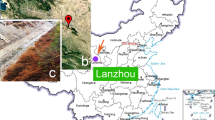Abstract
The fine morphology of epidermal ciliary structures in four species of the Nemertodermatida and four species of the Acoela was studied, with emphasis on Meara stichopi (Nemertodermatida). The cilium of M. stichopi has a distal shelf and is proximally separated from the basal body by a cup-shaped structure. The bottom of the cup consists of a bilayered dense plate, or basal plate. The basal body consists of peripheral microtubule doublets continuous with those of the cilium. In the upper part of the basal body, the doublets are set at an angle and are anchored to the enclosing cell membrane by Y-shaped structures. The lower part of the basal body tapers eventually. The striated main rootlet arises on the anterior face of the basal body, initially like a flattened strap, and continues along the basal body shaped as a tube which further down becomes solid. The hour-glass-shaped posterior rootlet arises on the posterior face of the basal body. Contrary to the main rootlet, the striations in the proximal part of the posterior rootlet run parallel to the microtubule doublets of the basal body. A pair of microtubule bundles lead from the posterior rootlet to the two main rootlets in the hind ciliary row, and follow these to their lower tip. In the other species of the Nemertodermatida studied, the structure of the ciliary basal body and the ciliary rootlets is similar to that of M. stichopi. Structural differences in the species of the Acoela are that the lowermost end of the basal body is narrow and bent forwards, the proximal part of the main rootlet is trough-shaped, the main rootlet is accompanied by a pair of lateral rootlets and the posterior rootlet with associated microtubule bundles is thin. The epidermal ciliary structures in species of the Nemertodermatida and Acoela have a number of shared characters which are unique within the Plathelminthes. However, almost all of these characters are found in Xenoturbella bocki (Xenoturbellida), and some even in species of other ”phyla” of the ”lower” Metazoa. Hence, these characters cannot be considered apomorphic for the Acoelomorpha. A character seemingly present only in species of the Nemertodermatida and Acoela is the bilayered dense plate. This feature might represent an autapomorphic character state for the Acoelomorpha.
Similar content being viewed by others
Author information
Authors and Affiliations
Additional information
Accepted: 7 March 1997
Rights and permissions
About this article
Cite this article
Lundin, K. Comparative ultrastructure of the epidermal ciliary rootlets and associated structures in species of the Nemertodermatida and Acoela (Plathelminthes). Zoomorphology 117, 81–92 (1997). https://doi.org/10.1007/s004350050033
Issue Date:
DOI: https://doi.org/10.1007/s004350050033




